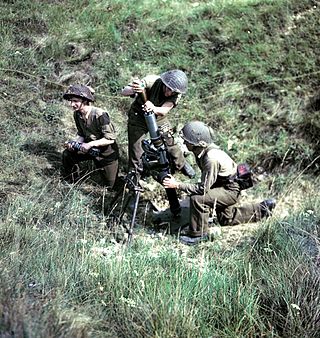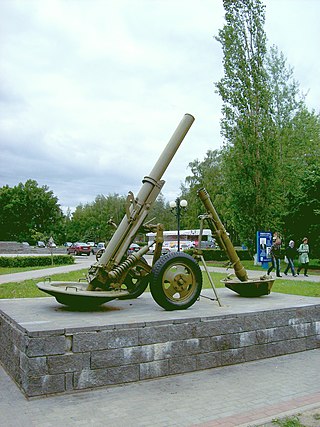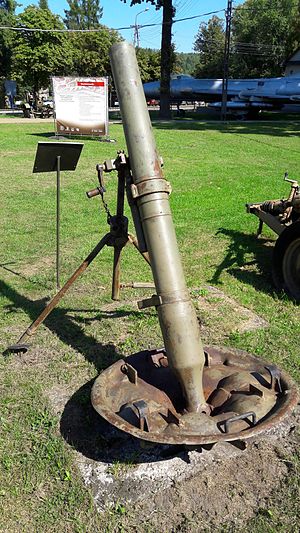
The DShK 1938 is a Soviet heavy machine gun. The weapon may be vehicle mounted or used on a tripod or wheeled carriage as a heavy infantry machine gun. The DShK's name is derived from its original designer, Vasily Degtyaryov, and Georgi Shpagin, who later improved the cartridge feed mechanism. It is sometimes nicknamed Dushka in Russian-speaking countries, from the abbreviation.

The M40 recoilless rifle is a portable, crew-served 105 mm recoilless rifle made in the United States. Intended primarily as an anti-tank weapon, it could also be employed in an antipersonnel role with the use of an antipersonnel-tracer flechette round. The bore was commonly described as being 106 mm caliber but is in fact 105 mm; the 106 mm designation was intended to prevent confusion with incompatible 105 mm ammunition from the failed M27. The air-cooled, breech-loaded, single-shot rifle fired fixed ammunition and was used primarily from a wheeled ground mount or M92 ground mount. It was designed for direct firing only, and sighting equipment for this purpose was furnished with each weapon, including an affixed M8C .50 cal spotting rifle.

The M1 mortar is an American 81 millimeter caliber mortar. It was based on the French Brandt mortar. The M1 mortar was used from before World War II until the 1950s when it was replaced by the lighter and longer ranged M29 mortar.

The 120-PM-38 or M1938 was a 120 mm Soviet mortar that was used in large numbers by the Red Army during World War II. Although a conventional design its combination of light weight, mobility, heavy firepower and range saw its features widely copied by successive generations of mortars.

The M30 106.7 mm heavy mortar is an American rifled, muzzle-loading, high-angle-of-fire weapon used for long-range indirect fire support to infantry units.

The Ordnance ML 3-inch mortar was the United Kingdom's standard mortar used by the British Army from the early 1930s to the late 1960s, superseding the Stokes mortar. Initially handicapped by its short range compared to similar Second World War mortars, improvements of the propellant charges enabled it to be used with great satisfaction by various armies of the British Empire and of the Commonwealth.

The KPV heavy machine gun is a Soviet designed 14.5×114mm-caliber heavy machine gun, which first entered service as an infantry weapon in 1949. In the 1960s, the infantry version was taken out of production because it was too large and heavy. It was later redesigned for anti-aircraft use, as it showed excellent results as an AA gun against low flying aircraft, with a range of 3,000 m (9,800 ft) horizontally and 2,000 m (6,600 ft) vertically. It was used in the ZPU series of anti-aircraft guns. Its size and power also made it a useful light anti-armour weapon on the BTR series of vehicles and the BRDM-2 scout car.
The M19 Mortar is a light, smoothbore, muzzle-loading, high-angle-of-fire weapon for light infantry support developed and produced in the United States. It has been replaced in service by the more modern 60 mm M224 mortar, which has a much longer range and improved ammunition.

The 76 mm mountain gun M1938 was a Soviet gun used in World War II.

The Soviet 160 mm Mortar M1943 is a smoothbore breech loading heavy mortar which fired a 160 mm (6.3 in) bomb. The M1943 was one of the heaviest mortar used by Soviet troops in World War II. Around 535 of these weapons were fielded with Soviet forces during the war. It was replaced in Soviet service after World War II by the M-160 mortar of the same caliber.

The 8 cm Granatwerfer 34 was the standard German infantry mortar throughout World War II. It was noted for its accuracy and rapid rate of fire.

The M2 4.2-inch mortar was a U.S. rifled 4.2-inch (107 mm) mortar used during the Second World War, the Korean War, and the Vietnam War. It entered service in 1943. It was nicknamed the "Goon Gun" or the "Four-Deuce". In 1951, it began to be phased out in favor of the M30 mortar of the same caliber.

The 82-PM-41, M-41 or the 82-mm mortar Model 1941 was a Soviet 82-millimeter calibre mortar developed during the Second World War as an infantry battalion mortar, and which began production in 1941.

The M1943 Mortar or 120-PM-43 or the 120-mm mortar Model 1943, also known as the SAMOVAR, is a Soviet 120 millimeter calibre smoothbore mortar first introduced in 1943 as a modified version of the M1938 mortar. It virtually replaced the M1938 as the standard weapon for mortar batteries in all Soviet infantry battalions by the late 1980s, though the armies of the Warsaw Pact utilised both in their forces.

The M-37 or 82-BM-37 is a Soviet 82 millimeter calibre mortar designed by B.I. Shavyrin and accepted into service in 1937. The design of the M-37 is based on the earlier French Brandt mle 27/31 mortar with Russian modifications. The main difference between the 82-PM-37 and the earlier 82-PM-36 was the adoption of a round base plate, revised traverse/elevation controls, simplified sights and spring-loaded shock absorbers on the bi-pod to reduce the amount of relaying needed between shots. It was designed to be able to fire western 81 mm captured ammunition whilst not permitting the enemy the same advantage The German designation for captured M-37 mortars was 8.2 cm GrW 274/2(r).

The M29 is an American-produced 81 millimeter mortar. It began replacing the M1 mortar in U.S. service in 1952 being lighter and with greater range. It was subsequently replaced by the M252 mortar in 1987. Variants included the M29E1 and M29A1, adopted in 1964. These were produced with a hard chrome-plated bore to prolong barrel life and ease of cleaning.

The RPD is a 7.62x39mm light machine gun developed in the Soviet Union by Vasily Degtyaryov for the 7.62×39mm M43 intermediate cartridge. It was created as a replacement for the DP machine gun chambered for the 7.62×54mmR round. It is a precursor of most squad automatic weapons. It was succeeded in Soviet service by the RPK.

The Ordnance ML 4.2-inch mortar was a heavy mortar used by the British Army during and after World War II.

The Type 63 multiple rocket launcher is a towed, 12-tube, 107mm rocket launcher produced by the People's Republic of China in the early 1960s and later exported and manufactured globally. Although no longer serving with active infantry units, the Type 63 is still in People's Liberation Army service with specialized formations such as mountain infantry units and special forces detachments. The Type 63 was widely used in the PLA until the late 1980s. It was adopted as the successor of the Type 50-5 of 102mm.

The Laotian Civil War was a military conflict that pitted the guerrilla forces of the Marxist-oriented Pathet Lao against the armed and security forces of the Kingdom of Laos, led by the conservative Royal Lao Government, between 1960 and 1975. Main combatants comprised:



















